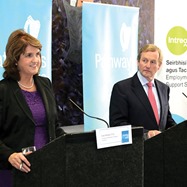Pathways to Work 2015 launched
 Michael McKernan examines the latest steps in the Government’s effort to help jobless people into work.
Michael McKernan examines the latest steps in the Government’s effort to help jobless people into work.
The Taoiseach and Tánaiste recently launched the 2015 iteration of the Government’s Pathways to Work strategy, which this year has an emphasis on the young and long-term unemployed, as well as a “particular focus on employer engagement”.
Pathways to Work was first launched in 2012 to run as a four-year over-arching programme aimed at intensifying government efforts to reduce unemployment following the dramatic increase in joblessness which followed the economic crash in 2008. The strategy, including the 2015 update, is based on five ‘strands’ of policy and intervention:
1. incentivising employers to provide more jobs for unemployed people;
2. better engagement with unemployed persons themselves;
3. greater targeting of activation places and opportunities for long-term unemployed;
4. incentivising the take-up of employment opportunities; and
5. completing the reform agenda.
The strategy sits alongside the Government’s Action Plan for Jobs which focuses entirely on employment creation. Pathways to Work is about making sure that as many as possible of the jobs created are taken up by people on the live register. The 2015 strategy includes the establishment of a further 16 Intreo centres in addition to the 44 already opened around the country. The Intreo centres are specially designed one-stop shops for training and employment services for the unemployed, run collaboratively by the Department of Social Protection and Department of Education and Skills. Under the 2015 plan, these centres will be publicly benchmarked to ensure that they are performing properly and meeting their targets.
Another key action in Pathways to Work 2015 is the establishment of an ‘employment and youth activation charter’. This initiative invites employers to sign a charter committing them to ensuring that at least 50 per cent of candidates interviewed for jobs will be coming from the live register. To assist in this process, employers will have dedicated account managers in the Department of Social Protection. The 2015 strategy also sees the roll-out of further youth guarantee initiatives supporting young jobseekers and provides more places on programmes aimed at raising skill levels and improving employability.
Pathways to Work 2015 also seeks to ensure that those who return to work are actually financially better off in work. To this end, the introduction of a working family dividend is designed to allow jobseekers returning to work to retain, for a set period, welfare payments known as qualified child increases for their children.
The Government can point to some significant successes since Pathways to Work was first launched. The numbers on the live register have fallen by 70,000 since 2012 and unemployment at 10.7 per cent is the lowest that it has been for five years. Youth unemployment remains stubbornly high at 27 per cent but has come down from 33 per cent since 2012. The problem, though, is that the Government is unsure how much of this progress is a direct result of the Pathways to Work strategy and how much is due to general improvement in the economy. The 2015 iteration of Pathways to Work therefore includes a detailed evaluation of the programme itself.
For all the progress made, there is still a long way to go before unemployment returns to pre-downturn levels. However, with the increased focus on performance measurement in 2015, the Tánaiste and Minister of Social Protection Joan Burton is clear that “pressure will be maintained to ensure we meet and exceed our targets.”





